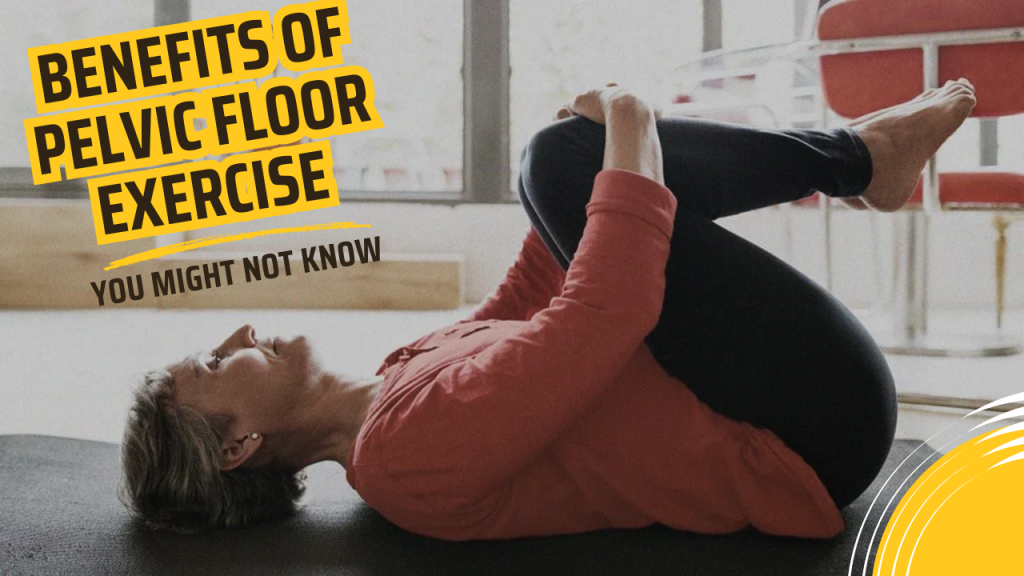“Your core isn’t just your abs—your true foundation lies deeper, in the muscles you rarely think about.”
While most fitness routines focus on visible muscle groups, there’s one set of hidden muscles that can profoundly impact your health, posture, intimacy, and confidence—the pelvic floor. These internal muscles act as a hammock, supporting vital organs like the bladder, uterus, bowel, and prostate, and they play a critical role in everyday function and well-being.
Fortunately, you don’t need a gym membership or fancy equipment to strengthen them. Pelvic floor exercises (commonly known as Kegels) are simple, discreet, and effective. And their benefits go far beyond just bladder control.
Let’s dive into the powerful benefits of regularly training your pelvic floor—and why everyone, not just postpartum women, should be doing it.

Table of Contents
What Is the Pelvic Floor?
The pelvic floor is a group of muscles and connective tissues that stretch across the bottom of the pelvis like a supportive sling. These muscles support your internal organs, help control urination and bowel movements, and play a key role in sexual function, spinal alignment, and core strength.
12 Incredible Benefits of Pelvic Floor Exercises
1. Improves Bladder and Bowel Control
Pelvic floor training helps reduce urinary incontinence, urgency, and nighttime urination. It also supports bowel health by preventing fecal leakage and promoting more regular, controlled bowel movements.
2. Boosts Sexual Satisfaction
For women, stronger pelvic muscles can enhance arousal and orgasm. For men, they can improve erectile strength and ejaculation control. A healthy pelvic floor increases blood flow and nerve sensitivity, enhancing overall sexual function and confidence.
3. Supports Pregnancy and Postpartum Recovery
During pregnancy, the pelvic muscles stretch to support a growing baby. After birth, exercises help restore tone, support healing, and reduce the risk of prolapse or leakage.
4. Prevents Pelvic Organ Prolapse
A strong pelvic floor keeps your bladder, uterus, and rectum in their proper positions. This lowers the risk of pelvic organs descending or bulging into the vaginal wall—an issue that can affect comfort and function.
5. Improves Core Strength and Stability
The pelvic floor is an essential part of your core muscle system, along with your diaphragm, abdominal, and back muscles. Strengthening it can improve posture, coordination, and overall body stability.
6. Reduces Lower Back and Pelvic Pain
Weak or unbalanced pelvic muscles can lead to chronic lower back pain or hip discomfort. Strengthening these muscles promotes proper alignment and reduces strain on your spine and hips.
7. Improves Posture and Body Mechanics
Pelvic floor training enhances spinal alignment and supports upright posture, making your movement patterns more efficient and reducing injury risk.
8. Enhances Athletic Performance
A stable and well-functioning pelvic floor can improve breathing mechanics, lifting technique, and explosive power, making it especially beneficial for athletes, runners, dancers, and weightlifters.
9. Speeds Up Recovery After Prostate Surgery
For men who undergo prostate procedures, pelvic floor exercises can help them regain urinary control faster and reduce complications related to erectile function.
10. Promotes Hormonal Balance and Circulation
Improved blood flow from pelvic training supports healthy reproductive organs and may even assist in regulating menstrual cycles and relieving PMS symptoms.
11. Eases Menopause-Related Issues
During menopause, declining estrogen levels can weaken pelvic tissues. Kegel exercises help maintain pelvic strength, reduce dryness, and prevent urinary urgency or vaginal laxity.
12. Increases Body Awareness and Mind-Body Connection
Like yoga or Pilates, pelvic floor training boosts your internal awareness. Over time, you become more in tune with your breathing, posture, and internal muscle coordination.
Who Should Do Pelvic Floor Exercises?
These exercises are suitable for:
- Women: Pregnant, postpartum, menopausal, or otherwise
- Men: Especially those with prostate issues or core weakness
- Older adults: To maintain continence and prevent falls
- Athletes: For added core power and injury prevention
- Office workers: Sitting for long hours weakens the pelvic floor
- Anyone with bladder leaks, back pain, or low libido
How to Perform Kegel (Pelvic Floor) Exercises
- Identify the muscles: Try stopping urination mid-flow (don’t do this regularly). The muscles you use are your pelvic floor.
- Engage the muscles: Squeeze as if you’re stopping urine and gas at the same time.
- Hold: Start by holding for 3–5 seconds, then relax for 3–5 seconds.
- Repeat: Aim for 10–15 repetitions three times daily.
- Progress: As you get stronger, increase the hold time to 10 seconds.
Do not clench your glutes, thighs, or hold your breath. The focus should remain internal and gentle.
Mistakes to Avoid
- Doing Kegels while urinating regularly (can lead to incomplete emptying)
- Overdoing it (can lead to pelvic pain or tightness)
- Not breathing or engaging other muscle groups
- Being inconsistent
Bonus Tip: Combine with Breathwork or Yoga
To enhance the benefits, integrate pelvic floor training with deep diaphragmatic breathing, Pilates, or yoga poses like the bridge pose or happy baby. This helps connect your pelvic floor to your entire core and nervous system.
When to Seek Professional Help
If you’re unsure whether you’re activating the right muscles or you’re experiencing ongoing discomfort, it’s wise to consult a pelvic floor physiotherapist. They can offer personalized feedback and treatment.
Final Thoughts
Pelvic floor exercises may be invisible, but their results are not. From boosting sexual health and preventing incontinence to improving posture and enhancing your athletic ability, the benefits are too powerful to ignore.
Take five minutes a day to invest in your pelvic floor—it’s a small effort for a lifetime of strength and confidence.
Frequently Asked Questions (FAQs)
How often should I do pelvic floor exercises?
For best results, aim for 3 sets of 10–15 repetitions daily. Consistency is key. It may take a few weeks to notice improvements, but benefits build up over time.
How do I know I’m doing pelvic floor exercises correctly?
You should feel a gentle lift and squeeze inside your pelvis, like stopping urine flow or preventing gas. If you’re unsure, a pelvic floor physiotherapist can help you assess your technique.
Can pelvic floor exercises help with incontinence?
Yes! Pelvic floor training is one of the most effective natural ways to reduce or eliminate urinary and fecal incontinence, especially stress and urge incontinence.
Can pelvic floor exercises be done during pregnancy?
Yes, and they are highly recommended. They help support the growing uterus, reduce the risk of incontinence, and promote faster postpartum recovery.





